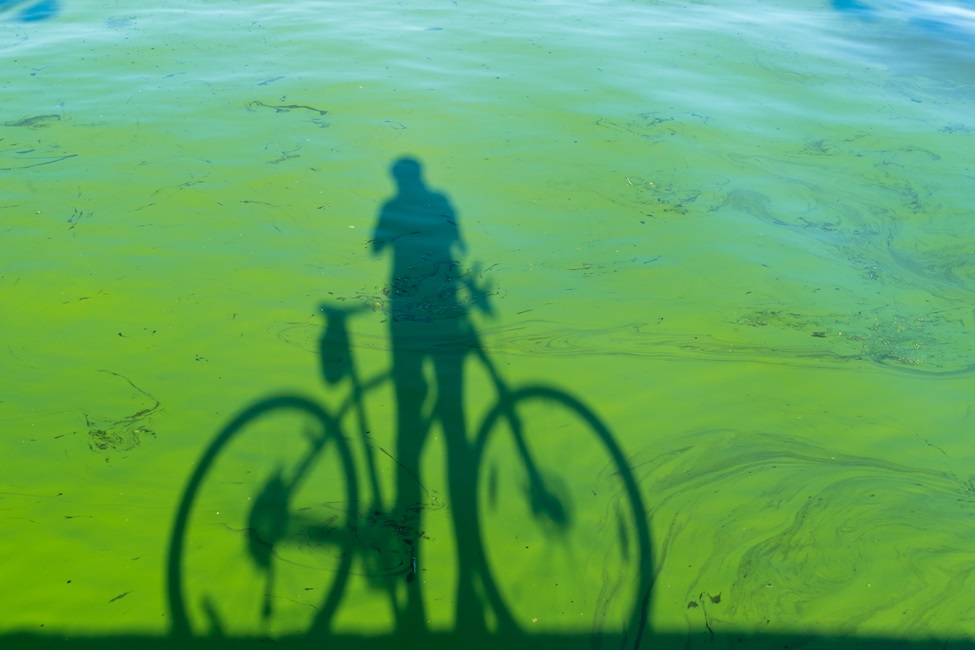FAU Seeks Participants for Study on Effects of Harmful Algal Blooms

Despite numerous occurrences of red tide and blue green algae in Florida waters, understanding of the long-term health effects of exposure to these blooms remains limited.
During harmful algal blooms, species of cyanobacteria release a variety of toxic compounds including microcystins, a potent toxin, into local waterways. Human exposure comes from ingestion, direct skin contact or inhalation, and can lead to a variety of symptoms ranging from gastroenteritis, nausea, allergic reactions and skin rashes to liver damage in severe cases. Despite numerous occurrences of red tide and blue green algae in Florida waters, our understanding of the long-term health effects of exposure to these blooms remains limited.
Researchers from Florida Atlantic University’s Christine E. Lynn College of Nursing and Harbor Branch Oceanographic Institute are seeking additional participants for a study evaluating potential impacts of exposure to harmful algal blooms. With another grant from the Florida Department of Health (FDOH), they are continuing the first-of-its-kind evaluation of both the short-term and potential long-term health effects among Florida residents. The “Long-term Effects of Exposure to Harmful Algal Blooms” (LEE-HABs) study uses a collaborative, multisite approach, which includes researchers from Florida Gulf Coast University.
The research team currently has an active cohort, and they are recruiting 30 additional participants this year. They will be recruiting and collecting non-bloom data for the Cape Coral area at the Public Works Department, 815 Nicholas Parkway East, on Dec. 13 from 12:30 to 4:30 p.m., and Dec. 14 from 8 a.m. to noon. Appointments are available and walk-ins are welcome.
This latest study expands upon prior studies conducted in 2016, 2018 and previous FDOH studies from 2019 to 2020 and 2021 to 2022.
“We have minimal data on health outcomes related to human exposure, despite the prevalence and intensity of cyanobacterial blooms in South Florida,” said Rebecca S. Koszalinski, Ph.D., principal investigator and an associate professor in the Christine E. Lynn College of Nursing. “Understanding short- and long-term health impacts and outcomes is crucial to protecting the health of Floridians. By developing tools to measure concentrations of harmful algal blooms toxins in the environment and multiple human tissues, we will gain a better understanding of health-related outcomes and health care needs in Florida and elsewhere.”
The study also is the first to evaluate the potential effect of exposure to COVID-19. Researchers are exploring if there is a relationship between a history of being infected with COVID-19 and susceptibility to the effects of harmful algal blooms exposure.
The latest study involves a survey to identify the potential routes, duration and types of exposure to blooms through recreational and occupational activities. Researchers also will assess potential effects on individuals with pre-existing conditions such as asthma and chronic gastrointestinal disorders. Bloodwork including liver enzymes and renal markers also will be included in this study.
Algal toxin concentrations including microcystin and brevotoxin will be measured in blood, urine and nasal mucosa. The toxin levels also will be used to understand the dose-response relationships with self-reported respiratory, dermal and gastrointestinal symptoms. Urine and blood analyses will be conducted in collaboration with the United States Centers for Disease Control and Prevention, which is developing methodology to detect emerging algal toxins in human tissues.
The study includes conducting environmental sampling of water and air to measure potential sources of exposure.
Researchers have developed a bio-repository and participant registry to store the data and samples in collaboration with FAU’s Clinical Research Unit within the FAU Division of Research. The purpose is to build an ongoing infrastructure to support the team’s long-term studies on the health effects of exposure to current and emerging harmful algal blooms toxins and serve as a resource for researchers around the state.
Malcolm McFarland, Ph.D., a research associate at FAU Harbor Branch, is co-principal investigator of the study. The research team also includes Michael Parsons, Ph.D., co-investigator and a professor of marine science at Florida Gulf Coast University.
For more information or to participate in the study, call or text 561-297-4631, or email Dr. Rebecca Koszalinski at NurHAB@health.fau.edu. Community participants will receive up to $25 in gift cards as an incentive for participating in data collection activities each year.
-FAU-
Latest News Desk
- FAU Researcher Lands Grant for Personalized Cancer Radiation TherapyThe project, led by Wazir Muhammad, Ph.D., will employ AI, specifically deep reinforcement learning, to analyze multimodal data, improving cancer characterization and treatment for better patient outcomes.
- FAU/Mainstreet Poll: Harris Narrows Trump's Lead to 5 PointsNew FAU poll highlights current voter leanings that were examined immediately before U.S. President Joe Biden announced he was leaving the race.
- FAU's Executive MBA Among Top 50 MBA ProgramsFlorida Atlantic University's College of Business Executive MBA program was among the Top 50 Executive MBA programs in the country, according to 2024 rankings from Fortune.
- FAU Online MBA Program Climbs in RankingsFlorida Atlantic University's College of Business climbed up in the rankings for the Top 50 Online MBA Programs in the country, according to the 2024 rankings from The Princeton Review.
- National Poll Shows Small Trump Bump Post-Assassination AttemptA new poll of the battleground states of Georgia and Virginia highlights current voter leanings that were examined immediately before and after the attempted assassination of former U.S. President Donald Trump.
- FAU Nursing Faculty Named Fellows of the American Academy of NursingThree faculty members in the Christine E. Lynn College of Nursing have been named 2024 Fellows of the American Academy of Nursing for their extraordinary contributions to improve health locally and globally.






